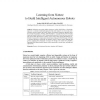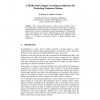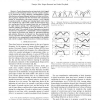41 search results - page 6 / 9 » An Adaptive Thin-Client Robot Control Architecture |
IROS
2006
IEEE
14 years 1 months ago
2006
IEEE
Information processing within autonomous robots should follow a biomimetic approach. In contrast to traditional approaches that make intensive use of accurate measurements, numeric...
ROBOCUP
1999
Springer
13 years 11 months ago
1999
Springer
In RoboCup-98, sparrows team worked hard just to get both a simulation and a middle size robot team to work and to successfully participate in a major tournament. For this year, we...
ESANN
2001
13 years 8 months ago
2001
Time varying environments or model selection problems lead to crucial dilemmas in identification and control science. In this paper, we propose a modular prediction scheme consisti...
ICRA
2007
IEEE
14 years 1 months ago
2007
IEEE
— Passive dynamics plays an important role in legged locomotion of the biological systems. The use of passive dynamics is expected for energy efficiency, self-stabilization agai...
ALIFE
2000
13 years 7 months ago
2000
The evolution of simulated robots with three different architectures is studied in this article. We compare a nonmodular feed-forward network, a hardwired modular, and a duplicatio...



